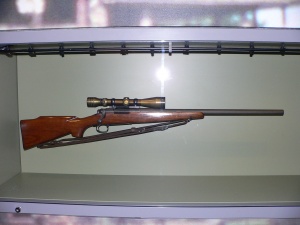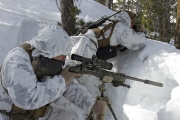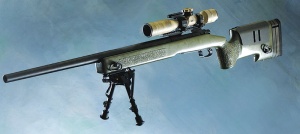Difference between revisions of "M40 rifle"
(Created page with "{{gun |name= M40 |image= Chuck Mawhinney's sniper rifle.jpg |caption= Chuck Mawhinney's M40 on display in the National Museum of the Marine Corps. |origin= [[United States...") |
Latest revision as of 12:28, 5 May 2013
| M40 | |
|---|---|

| |
| Chuck Mawhinney's M40 on display in the National Museum of the Marine Corps. | |
|
| |
| Type | Sniper rifle |
| Land of Origin | United States |
| Specifications | |
| Length | M40A1: 1,117 mm (43.97 in) M40A3: 1,124 mm (44.25 in) |
| Barrel length | 610 mm (24 in) |
| Weight | M40A1: 6.57 kg (14.48 lb) M40A3: 7.5 kg (16.5 lb) |
| Cartridge | 7.62×51mm NATO |
| Action | Bolt action |
| Rifling/Twist | 1:12 right hand twist M40A1: Hart (6 lands and grooves) M40A3: Schneider Match Grade SS #7 (6 lands and grooves) |
|
| |
| Muzzle velocity | 777 m/s (2,550 ft/s) (w/175 gr. M118LR) |
| Effective Range | 900 m (1000 yd) |
| Feed | 5-round integral box magazine (M40,M40A1,M40A3) 10-round removable box magazine (M40A5) |
| Sights | Scout Sniper Day Scope (SSDS)— Premier Reticles Heritage 3-15×50mm Tactical. |
| Service History | |
| In service | 1966–present |
| Used by | United States |
| Wars | Vietnam War Multinational Force in Lebanon Invasion of Grenada Gulf War War in Afghanistan Iraq War[1] |
| Production History | |
| Manufacturer | United States Marine Corps Remington U.S. Ordnance |
Each M40 is built from a Remington 700 bolt-action rifle, and is modified by USMC armorers at Marine Corps Base Quantico, using components from a number of suppliers.[2] New M40A5s are being built, and A1s are upgraded to A3s and A5s as they rotate into the armory for service and repair. The rifles have had many sub-variations in telescopic sights, and smaller user modifications. The M40A5 incorporates a detachable magazine and a threaded barrel to allow for the use of a sound suppressor or other muzzle device.
The original M40 was a military type-classified version of the Remington 700; it was factory-made, and had a one-piece wooden stock.[2] The M40A1 and A3 switched to fiberglass stocks made by McMillan, with new scopes.[2][5] The trigger pull on both models (M40A1/A3) is 3–5 lb (1.4–2.3 kg).[2]
Contents[hide] |
[edit] History
During the Vietnam War, the Marine Corps decided they needed a standard sniper rifle.[2] After testing several possibilities, they ordered 700 Remington Model 40x rifles (target/varmint version of the Model 700 bolt-action rifle), and gave them the M40 designation.[2] Most had a Redfield 3–9 power Accurange variable scope mounted. With time, certain weaknesses, primarily warping of the all-wood stock, became apparent.[2] Sometime in the early 1970s, the USMC armorers at MCB Quantico began rebuilding the original M40s into M40A1s.[2] The process involved, among other improvements, replacing the original wood stocks with McMillan A1 fiberglass stocks, as well as replacing the original Redfield scopes with Unertl scopes.[2] The M40 was originally designed by Jack Cuddy and Neill Goddard.[2] The stock featured Wichita sling swivels and a Pachmayr buttpad.[2]The Corps began looking at a replacement for the M40 series in 2004, but didn't draft requirements until 2009. The Sniper Rifle 21st century is paused while the Corps waits for the results of United States Special Operations Command (SOCOM)'s Precision Sniper Rifle program.[6]
[edit] M40A3
Development of the M40A3 began in 1996 and concluded in 2001,[5] when it was placed into service during Operation Enduring Freedom. It served in Operation Iraqi Freedom other subsequent conflicts. Though its designation would remain M40A3 until 2009, its exact configuration varied with time. Listed here is a description of the components used in the M40A3.
Action: The M40 has always been based on the Remington 700 Short Action with .308 bolt face, and this is no different in the M40A3. These actions are tuned by Marine armorers; the trigger guard assembly is manufactured by the DD Ross Company, though several M40A3s use Badger Ordnance trigger guards.[5] In 2007, the Marine Corps began replacing the DD Ross trigger guard assemblies with the M5 detachable magazine trigger guard manufactured by Badger Ordnance.
Barrel: The barrel is a Schneider 610; 24-inch, 6-groove, 1:12" match-grade heavy barrel.[7]
Stock: All service M40A3s are based upon the A4 Tactical Riflestock, a benchrest-style fiberglass riflestock made by McMillan Fiberglass Stocks and cast molded in an OD Green color.[5][7] The action is glass bedded into the stock with aluminum pillars, while the barrel is allowed to "float" (it is attached only to the action), ensuring it is stress free during operation. The stock has adjustable length-of-pull (through a buttstock spacer system) and a Marine manufactured adjustable saddle-type cheekpiece.[7] The stock also has six mount flush cups, two on each side front and back and one each on the front and rear underside.[5] One bipod stud is located on the underside of the forearm.[7]
Sling: The Model 1907 sling that has been historically used on M40A3s has been replaced with the Quick Cuff Model Two sling manufactured by Tactical Intervention Specialists.

Bipod: The M40A3s use a 6–9" Harris notched swivel type bipod with a KMW podlock.[7] The QD bipod attaching screw is replaced with a screw made by Jon Tank of Tanks Rifle Shop.
Dayscope: The Scout Sniper Day Scope, a modified Schmidt & Bender 3–12× 50 Police Marksman II LP rifle scope with illuminated reticle, has replaced the Unertl MST-100 10× fixed day scope, previously used on both the M40A1 and M40A3.[7] This dayscope is mounted with Badger Ordnance USMC M40A3 34mm scope rings, which use a standard ring in the rear and a wider MAX-50 ring in front.[5] The standard front ring cap is replaced with a SPA-Defense B634 34mm Male Dovetail, as a mounting platform for the Simrad KN200 Night Vision Weapon Sight. The scope and rings are mounted on a DD Ross 30 minute-of-angle lugged Picatinny rail.[5]
[edit] M40A5
The M40A5 designation superseded the M40A3 in 2009, though the evolution between the two systems occurred gradually over a longer period of time.[8] The primary difference between the M40A5 and the M40A3 is the barrel: The A3's target crown has been replaced with a threaded muzzle and straight tapered barrel to allow the installation of a Surefire muzzle brake and sound suppressor. All M40A5s are fitted with a Badger Ordnance detachable magazine system and a forward rail mount for the AN/PVS-22 night vision optic.[9]
[edit] Comparison
| Differences | ||
| M40A1 | M40A3 | |
| Weight | 6.57 kg (14.45 lb) | 7.5 kg (16.56 lb) |
| Overall Length | 1.117 m (44.0 in) | 1.124 m (44.25 in) |
| Barrel | Hart | Schneider Match Grade SS #7 |
| Lands and Grooves | 6 | 6 |
| Stock | McMillan HTG | McMillan Tactical A4 |
[edit] Differences between M40 and M24
The U.S. Army also uses the Remington 700/40x action as the basis for its M24 Sniper Weapon System.[2] The primary difference between the Army and the USMC rifles is that while the USMC M40/A1/A3 uses the short action version of the Remington 700/40x (designed for shorter cartridges, such as 7.62mm NATO, 7 mm/08 Remington, .243 Winchester), the Army M24 uses the long action version of the same rifle.[2] The long-action of the M24 can use the .308 Winchester (7.62×51mm NATO) but is mainly designed for full-length cartridges, such as the .30-06 Springfield, and magnum cartridges, such as the 7 mm Remington Magnum, .300 Winchester Magnum and .338 Lapua.[2] The U.S. Army's use of the long action was the result of an original intention to chamber the M24 for .30-06;[10] despite the change to .308 (7.62x51mm NATO), retaining the longer action allows them to reconfigure the rifle in the larger, longer-range calibers if necessary. Additionally the Army's version allowed mounting of a night vision scope, whereas the older USMC versions were tied to the daylight Unertl 10× limiting sniping operations with the M40 and M40A1 from dawn to dusk.[2]
[edit] Resources

This article or section is missing resources, such as diagrams or manual links, and could use more input to fill in the missing bits. You (yes, you!) can help Gunsopedia provide more comprehensive information to our users by using your own knowledge to add to it.
[edit] References
- ↑ Sasser, Charles and Craig Roberts (1990). One Shot, One Kill. New York: Pocket Books. p. 208. ISBN 0-671-68219-9.
- ↑ 2.00 2.01 2.02 2.03 2.04 2.05 2.06 2.07 2.08 2.09 2.10 2.11 2.12 2.13 2.14 2.15 Senich, Peter R. (1988). Complete Book of U.S. Sniping. Boulder, CO: Paladin Press. p. 28. ISBN 978-1-58160-610-2.
- ↑ Keene, R.R. (April 2009). "Precision Weapons Handmade by Marines, for Marines". Leatherneck Magazine: 37.
- ↑ "M40A1 Sniper Rifle." USMC Fact File, U.S. Marine corps
- ↑ 5.0 5.1 5.2 5.3 5.4 5.5 5.6 "M40A3 Sniper Rifle." M40A3, United States Marine Corps Scout Sniper Association
- ↑ Lamothe, Dan. "Corps fielding new semi-automatic sniper rifle." Marine Corps Times, March 17, 2011
- ↑ 7.0 7.1 7.2 7.3 7.4 7.5 "WTBN, MCB, CLNC, M40A3 Sniper Rifle." USMC Fact File, Marine Corps Base, Camp Lejeune
- ↑ http://www.i-mef.usmc.mil/external/15thmeu/news/news_2010_07_19.jsp
- ↑ http://www.leatherneckmagazine-digital.com/leatherneckmagazine/200904/?pg=36#pg36
- ↑ http://www.snipercentral.com/m24.htm
[edit] External links
- M40A1 Sniper Rifle on About.com
- M40 Magazine reviews
- M40A5
| [show] |
|---|
